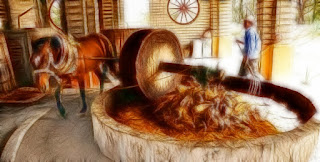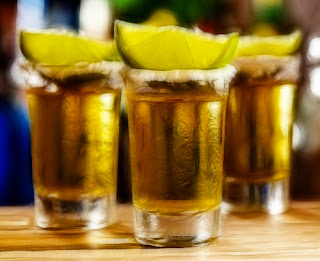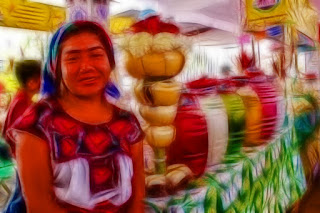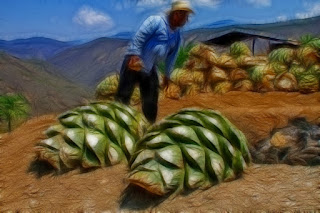Mezcal is the second-most popular Protected Designation of Origin of Mexico’s spirits. Unlike tequila’s standardised production method, mezcal is all about diversity. It can be made from over 40 agave varietals found in the nine designated states. Oaxaca, Guerrero, Guanajuato, San Luis Potosí, Zacatecas, Durango, Tamaulipas, Michoacán and Puebla are all part of the mezcal Protected Designation of Origin (PDO), spanning 500,000 km2 (193,000 sq. mi.) and making it the largest PDO in the world. But this enigmatic spirit hasn’t always been popular. Long ostracised, mezcal was portrayed as the poor man’s spirit. It is no secret that tequila has played a role in tarnishing mezcal’s reputation, favouring tequila over other agave spirits.
 |
| The word mezcal comes from Nahuatl mexcalli |
Mezcal (or mescal) (/mɛsˈkæl/) is a distilled alcoholic beverage made from any type of agave plant native to Mexico. The word mezcal comes from Nahuatl mexcalli [meʃˈkalːi] metl [met͡ɬ] and ixcalli [iʃˈkalːi] which means "oven-cooked agave".
A saying attributed to Oaxaca regarding the drink is: "Para todo mal, mezcal, y para todo bien, también." ("For every ill, mezcal, and for every good as well.").
It is unclear whether distilled drinks were produced in Mexico before the Spanish Conquest. The Spaniards were introduced to native fermented drinks such as pulque, made from the maguey plant. Soon, the conquistadors began experimenting with the agave plant to find a way to make a distillable fermented mash. The result was mezcal.
Today, mezcal is still made from the heart of the agave plant, called the piña, much the same way it was 200 years ago, in most places. In Mexico, mezcal is generally consumed straight and has a strong smoky flavor. Though mezcal is not as popular as tequila (made specifically from the blue agave in select regions of the country), Mexico does export the product, mostly to Japan and the United States, and exports are growing.
Despite the similar name, mezcal does not contain mescaline or other psychedelic substances.
It is unclear whether distilled drinks were produced in Mexico before the Spanish Conquest. The Spaniards were introduced to native fermented drinks such as pulque, made from the maguey plant. Soon, the conquistadors began experimenting with the agave plant to find a way to make a distillable fermented mash. The result was mezcal.
Today, mezcal is still made from the heart of the agave plant, called the piña, much the same way it was 200 years ago, in most places. In Mexico, mezcal is generally consumed straight and has a strong smoky flavor. Though mezcal is not as popular as tequila (made specifically from the blue agave in select regions of the country), Mexico does export the product, mostly to Japan and the United States, and exports are growing.
Despite the similar name, mezcal does not contain mescaline or other psychedelic substances.
Traditionally, mezcal is handcrafted by small-scale producers. A village can contain dozens of production houses, called fábricas or palenques, each using methods that have been passed down from generation to generation, some using the same techniques practiced 200 years ago.
The process begins by harvesting the plants, which can weigh 40 kg each, extracting the piña, or heart, by cutting off the plant's leaves and roots. The piñas are then cooked for about three days, often in pit ovens, which are earthen mounds over pits of hot rocks. This underground roasting gives mezcal its intense and distinctive smoky flavor. They are then crushed and mashed (traditionally by a stone wheel turned by a horse) and then left to ferment in large vats or barrels with water added.
 |
| The agave hearts are cooked, crushed and mashed. |
The mash is allowed to ferment, the resulting liquid collected and distilled in either clay or copper pots which will further modify the flavor of the final product. The distilled product is then bottled and sold. Unaged mezcal is referred to as joven, or young. Some of the distilled product is left to age in barrels between one month and four years, but some can be aged for as long as 12 years. Mezcal can reach an alcohol content of 55%. Like tequila, mezcal is distilled twice. The first distillation is known as punta, and comes out at around 75 proof (37.5% alcohol by volume). The liquid must then be distilled a second time to raise the alcohol percentage.
Mezcal is highly varied, depending on the species of agave used, the fruits and herbs added during fermentation and the distillation process employed, creating subtypes with names such as de gusano, tobalá, pechuga, blanco, minero, cedrón, de alacran, creme de café and more. A special recipe for a specific mezcal type known as pechuga uses cinnamon, apple, plums, cloves, and other spices that is then distilled through chicken, duck, or turkey breast. It is made when the specific fruits used in the recipe are available, usually during November or December. Other variations flavor the mash with cinnamon, pineapple slices, red bananas, and sugar, each imparting a particular character to the mezcal. Most mezcal, however, is left untouched, allowing the flavors of the agave used to come forward.
 |
| Mezcal produced using modern technology that can include autoclaves. |
Not all bottles of mezcal contain a "worm" (actually the larva of a moth, Hypopta agavis that can infest agave plants), but if added, it is added during the bottling process. There are conflicting stories as to why such would be added. Some state that it is a marketing ploy. Others state that it is there to prove that the mezcal is fit to drink, and still others state that the larva is there to impart flavor.
The two types of mezcal are those made of 100% agave and those mixed with other ingredients, with at least 80% agave. Both types have four categories. White mezcal is clear and hardly aged. Dorado (golden) is not aged but a coloring agent is added. This is more often done with a mixed mezcal. Reposado or añejado (aged) is placed in wood barrels from two to nine months. This can be done with 100% agave or mixed mezcals. Añejo is aged in barrels for a minimum of 12 months. The best of this type are generally aged from 18 months to three years. If the añejo is of 100% agave, it is usually aged for about four years.
Mexico has about 330,000 hectares cultivating agave for mezcal, owned by 9,000 producers. Over 6 million liters are produced in Mexico annually, with more than 150 brand names.
Regulation
Internationally, mezcal has been recognized as an Appellation of Origin (AO, DO) since 1994. There is also a Geographical Indication (GI), originally limited to the states of Oaxaca, Guerrero, Durango, San Luis Potosí and Zacatecas. Similar products are made in Jalisco, Guanajuato, Michoacán, and Tamaulipas, but these have not been included in the mezcal DO.
Within Mexico, mezcal is regulated under Norma Oficial Mexicana (NOM) regulations, originally NOM-070-SCFI-1994 (in 1994), by the industry body Consejo Mexicano Regulador de la Calidad del Mezcal A.C. (COMERCAM, the Mexican Regulatory Council for Mezcal Quality). This regulation became law in 2003, and certification began in 2005.
The regulations have been controversial, not only from small artisanal producers for whom the cost of certification is prohibitive, but also from traditional producers outside the chosen GI states. Not only are the latter prohibited from calling their product Mezcal, under the new regulation NOM 199 issued in late 2015, they must label it Komil, a little-known word for intoxicating drink from the Nahuatl language, and must not list the varieties of agave and maguey that are used.
 |
| For every ill, mezcal, and for every good as well. |
The industry generates about 29,000 jobs directly and indirectly. Certified production amounts to more than 2 million liters; 434,000 liters are exported, generating 21 million dollars in income. To truly be called mezcal, the liquor must come from certain areas. States that have certified mezcal agave growing areas with production facilities are Durango, Guanajuato, Guerrero, Oaxaca, San Luis Potosí, Tamaulipas, and Zacatecas. About 30 species of agave are certified for use in the production of mezcal. Oaxaca has 570 of the 625 mezcal production facilities in Mexico, but some in-demand mezcals come from Guerrero, as well. In Tamaulipas, 11 municipalities have received authorization to produce authentic mezcal with the hopes of competing for a piece of both the Mexican national and international markets. The agave used here is agave Americano, agave verde or maguey de la Sierra, which are native to the state.
Drinking
In Mexico, mezcal is generally drunk straight, not mixed in a cocktail. Mezcal is generally not mixed with any other liquids, but is often accompanied with sliced oranges, lemon or lime sprinkled with a mixture of ground fried larvae, ground chili peppers, and salt called sal de gusano, which literally translates as "worm salt".
 |
| In Mexico, mezcal is generally consumed straight. |
In the last decade or so, mezcal, especially from Oaxaca, has been exported. Exportation has been on the increase and government agencies have been helping smaller-scale producers obtain the equipment and techniques needed to produce higher quantities and qualities for export. The National Program of Certification of the Quality of Mezcal certifies places of origin for export products. Mezcal is sold in 27 countries on three continents. The two countries that import the most are the United States and Japan. In the United States, a number of entrepreneurs have teamed up with Mexican producers to sell their products in the country, by promoting its handcrafted quality, as well as the Oaxacan culture strongly associated with it.
Festival
The state of Oaxaca sponsors the International Mezcal Festival every year in the capital city, Oaxaca de Juárez. There, locals and tourists can sample and buy a large variety of mezcals made in the state. Mezcals from other states, such as Guerrero, Guanajuato, and Zacatecas also participate. This festival was started in 1997 to accompany the yearly Guelaguetza festival. In 2009, the festival had over 50,000 visitors, and brought in 4 million pesos to the economy.
 |
| The state of Oaxaca sponsors the International Mezcal. |
They are the indispensable element of any meeting between friends or family event, and what better than a good mezcal to accompany, for example: varieties of cheese, chapulines with chili and lemon or guacamole with tortilla chips. Fish: You can taste the mezcal ...
 |
| You can taste cheese or guacamole with the mezcal. |
Recipe Drink
Paloma De Mezcal (Dove of Mezcal)
 |
| Paloma De Mezcal (Dove Mezcal) |
The recipe is for 1 drink
2 oz agave nectar
1½ oz mezcal
1½ ounces fresh grapefruit juice (plus 1 grapefruit skin strip)
½ oz fresh lemon juice
Ice
2 oz soda
1 or 2 dashes Cynar (optional)
Make an agave syrup by mixing the nectar with 2 ounces of water in a bowl or jar. They will be left over for the next rounds.
In a cocktail shaker mix the mezcal, the grapefruit juice, the lemon juice and ½ ounce of the syrup. Add a little ice and shake for a moment (only to cool, not to dilute).
Pass, straining, to a glass; Add the soda, new ice and the dashes of Cynar if they found it. Take the strip of grapefruit skin and squeeze it on the glass, twisting it to release its oils. Cheers!.




